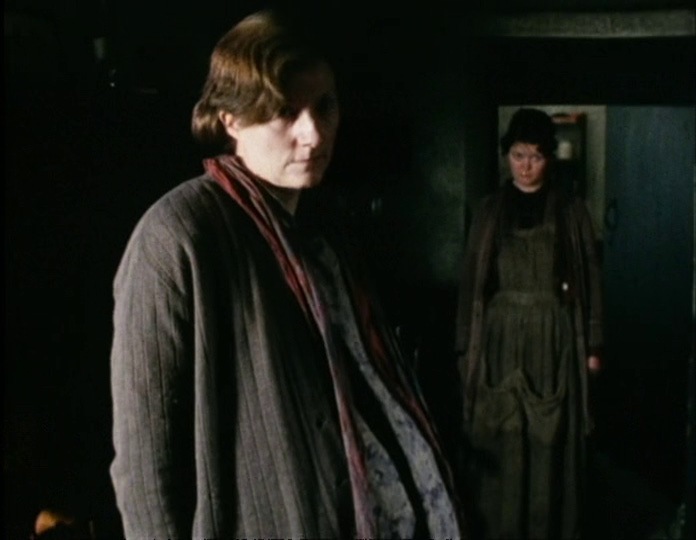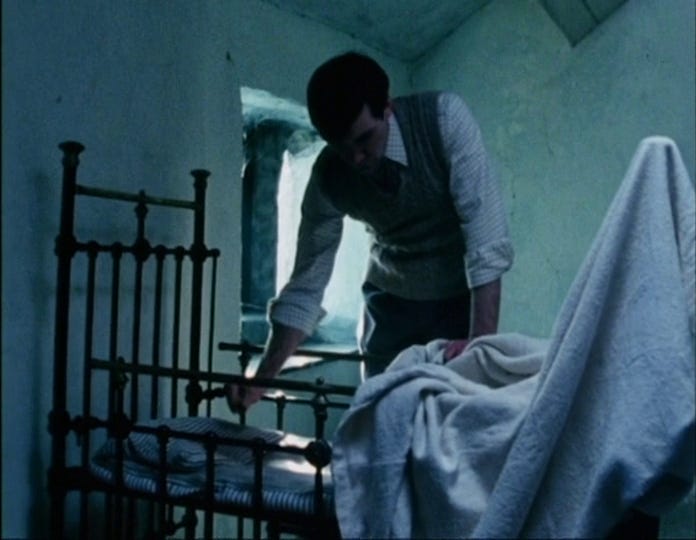Minor Horror #02-2: The Intercessor
This is the second in a series of fifteen pieces on “minor” horror films that I’m going to be publishing here throughout October. For more information, please see this post from last year, when I first did this.
The Intercessor (Peter Smith, 1983)
The Intercessor was the second teleplay produced for the anthology series Shades of Darkness, which ran for two seasons on Granada Television, a regional station serving northwestern England and the Isle of Man. Wikipedia tells us the station “was particularly noted by critics for the distinctive northern and ‘social realism’ character of many of its network programmes [sic], as well as the high quality of its drama and documentaries.” Shades of Darkness is virtually forgotten today – there was a DVD set put out with most of the episodes in 2006, but it’s long out of print, and there doesn’t seem to be much demand for a reissue. Sometimes a series like this ends up with a real cult following, even decades after it went off the air. This one didn’t. I found The Intercessor on YouTube, uploaded by a channel called “No Remaining Commercial Potential,” which I think kind of says it all. The internet is full of channels like this, devotees of the small screen uploading great batches of forgotten programming from some trove of hoarded tapes – and to be clear, I’m of the opinion that this is a great public service, one of those things that justifies the existence of the internet, if anything does. You would be far better off pulling up something from one of these uploaders next time you need some background noise while you eat, rather than whatever the Algorithm is trying to serve you (not that I’m very good about practicing what I preach in this regard). Anyway, I digress. I checked out The Intercessor because I was coming down from an acid trip and wanted something gentle and old-fashioned and supernatural in a low-stakes sort of way to help me relax, and this is exactly what I got. It’s not a great film or a forgotten masterpiece, but it is quite good, and atmospheric, and emotionally generous, moving in an understated way, and it would be nice if it was a little better remembered. It’s a modest thing, with modest ambitions, but there’s never been anything wrong with that.
It would be easy to mistake The Intercessor for an M. R. James adaptation, concerning as it does a scholarly young man who takes a room in a gloomy Yorkshire farmhouse in the hopes of finding the peace and quiet necessary to finish the county history he’s been working on – it’s not, though. The source here, rather, is a story by May Sinclair, turn-of-the-century English novelist, poet, suffragist, parapsychology enthusiast, and literary critic credited with the first usage of the term “stream of consciousness” to describe a written narrative. Among her numerous publications are two volumes of supernatural fiction, the latter of which (published 1931, not long before Parkinson’s forced her into retirement) bears the title The Intercessor and Other Stories. I include all this information because Sinclair seems like a very interesting person, and I’m not sure if I would have ever learned about her if I hadn’t gotten curious about this teleplay. As far as I can tell, it’s her only screen adaptation (small- or big-), which seems strange to me – surely there’s more to be explored here (her work is in the public domain now, if anyone would like to take a crack at it). In any case, we have The Intercessor, at least, and that’s not nothing.
It’s a very simple sort of story: the young man begins hearing strange noises at night, like a child crying, from the room at the end of the hall, which is empty, but always kept locked. The family living there (it’s unclear to me whether they really qualify as “farmers” – the place is rundown and weed-choked in a way that makes it hard to imagine anything agriculturally productive is happening there), a husband and wife and their teenage niece are “country people,” which is to say gruff, uneducated, possibly illiterate, distrustful of outsiders, and mostly just trying to mind their own business. They are not happy people. They’re grievously poor, yes, but there is clearly something else at work, some greater, less fathomable darkness which hangs over them and which is sapping their lives of joy. The days are grey and the nights black and whatever it is that haunts these people, they don’t want to talk about it, especially not with a stranger. It’s not a very welcoming environment, to say the least, but the young man stays on anyway – it’s the only place around he feels able to properly focus. The crying bothers him, though, enough that before long, he just has to get up and investigate it. He doesn’t find anything, not at first, but then things progress: another night, he sees a little girl dressed in white. She’s certainly the one who’s been crying. He asks about her the next day, but can’t get a straight answer, just averted eyes, mumbling, shuffling feet. Later, she appears at the door to his room. He invites her in, and she curls up and falls asleep next to him in his bed. He’s surprised, but lets her stay. When he mentions this the next day, the man of the house is astonished: again and again he repeats, in disbelief, “Ye don’t mind?” His voice quavers. He is overcome with emotion. He blesses the young man. It’s obvious to us, by now, at least some part of what’s going on – the little girl must be a ghost, the family must be somehow entangled in her death. It’s also obvious, though, that this is not an ordinary sort of ghost story. There doesn’t seem to be anything really menacing, much less actually malevolent, about this ghost; it seems like all she wants is to be seen, and accepted, and shown a little tenderness. The family can’t do this, for some reason, but this young man can – being an outsider, he has no idea about who this girl is, or what happened to her. And anyway, he’s a level-headed sort of man – why would he be scared of sad little girl? He knows no reason to be, and so he can do what those who do know a reason cannot. He can intercede.
A horror story is almost(?) always, on some level, about an encounter between a model of experience and something which breaks that model in a fundamental way, something which is simply not encompassed by it – a haunted house which loops back impossibly upon itself and a serial killer who tortures his victims in a dingy basement can be the same, in this regard. Generally these encounters are scarring, damaging, traumatizing events, often ending in death, mental collapse, eternal torment in evil dimensions, etc., but they don’t really have to be. I mean, lots of horror movies have “happy endings,” although it’s often debatable how “happy” these really are (is it really such a great relief to have survived Art the Clown, if all your friends have been slaughtered by him?). More to the point, we can consider something like Penda’s Fen, which is often labeled a “horror movie,” and indeed, it does have some fabulously scary sequences – but if you’ve watched it you’ll know that the place all those scary sequences are going is one of self-actualization and self-discovery, a coming-of-age which is radically, profoundly transformative in an entirely positive way, the throwing off of the shackles of reactionary false consciousness and the embrace of the true, bottomlessly rich heterogeneity of human thought, experience, and tradition. The Intercessor, as I said above, is a modest work with modest ambitions, so it isn’t trying to reach for anything so revelatory – nonetheless, though, there is a certain structural similarity. Both are films in which a young man encounters something he does not understand, something which, yes, at times scares him, and which affects him profoundly. In the one, the purpose of all this is a coming-of-age. In the other, in The Intercessor, it’s a matter of healing a troubled home. It feels a little strange trying to fit narratives like these into the category of “horror,” but I think it’s right. Horror is how we deal with the things we can’t deal with. I think it’s good, probably necessary, to be reminded sometimes that those things aren’t always trying to destroy us.




